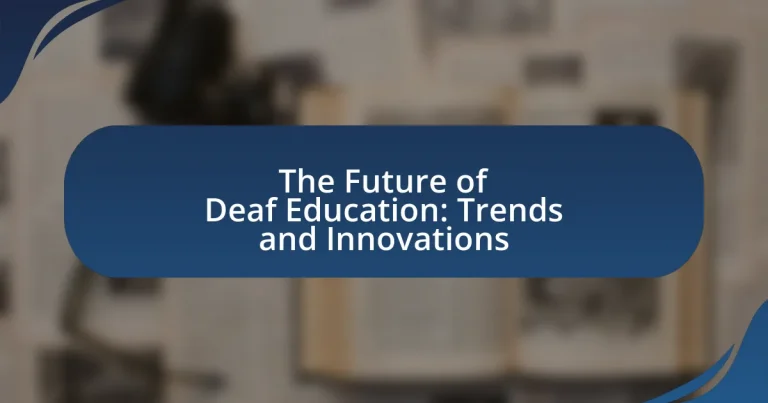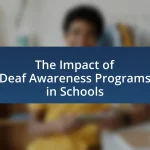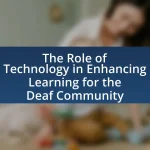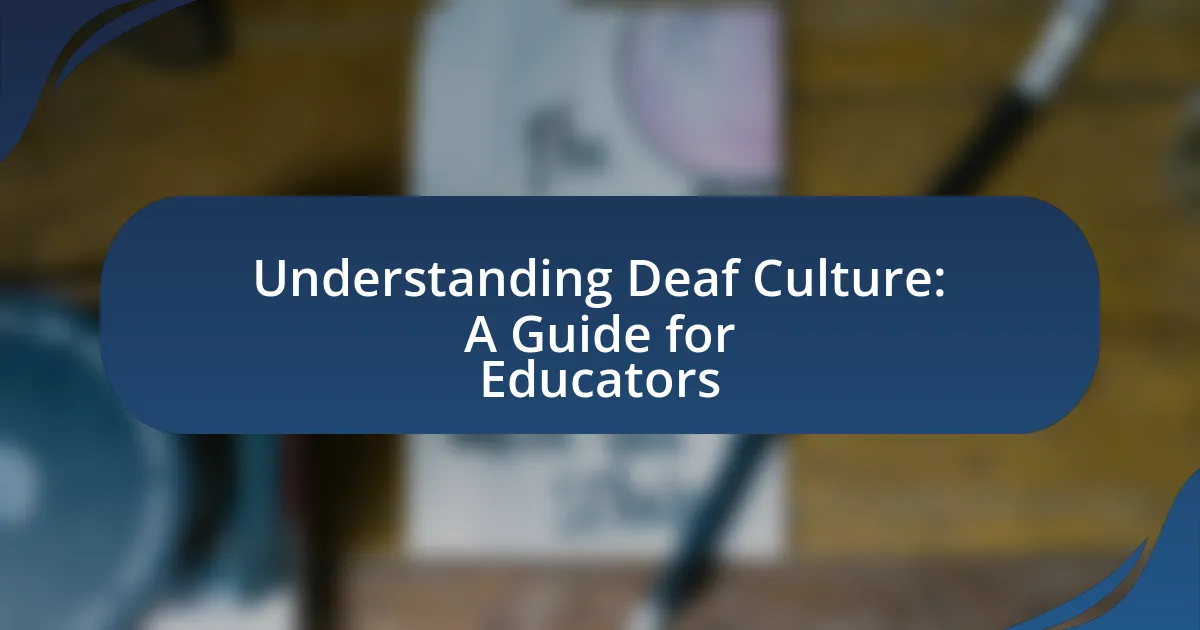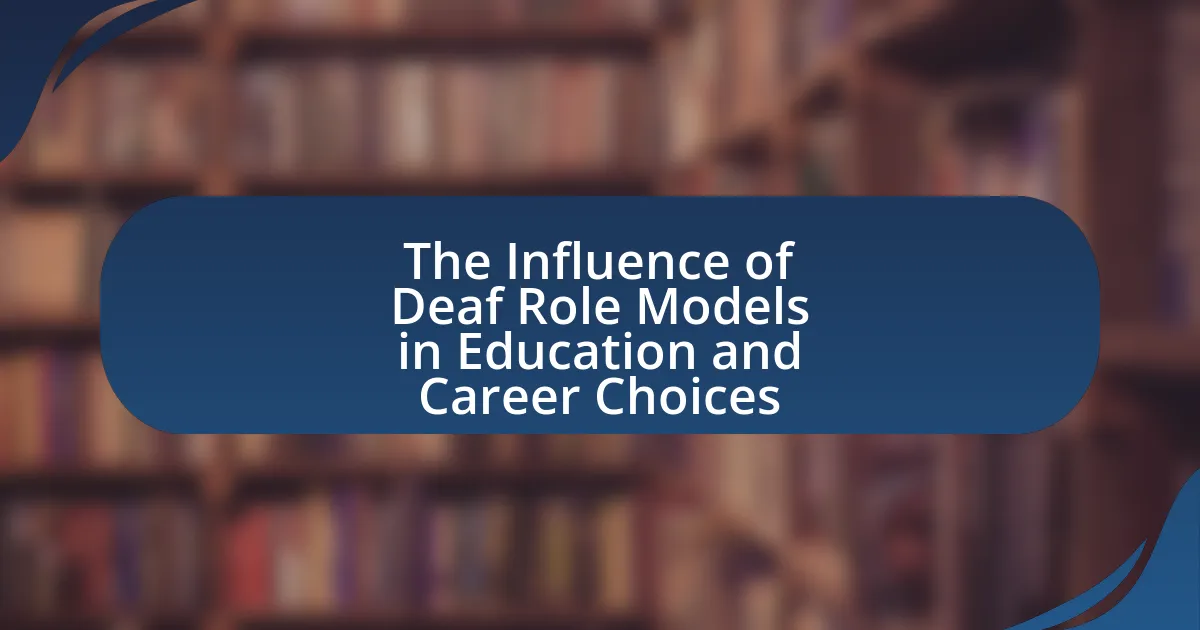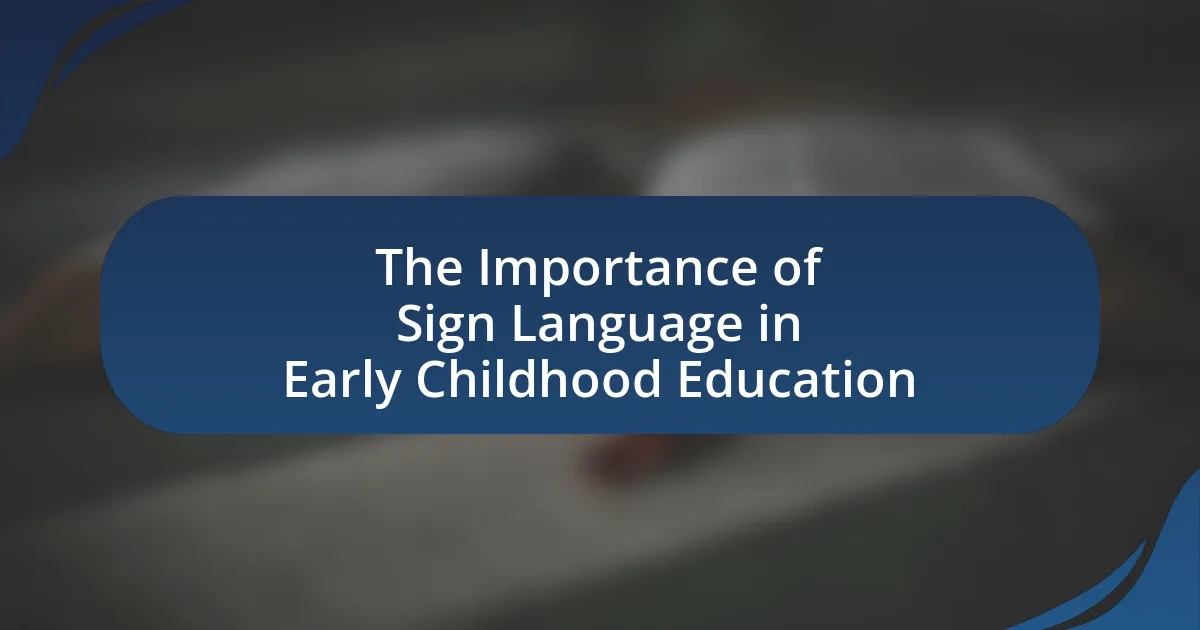The article “The Future of Deaf Education: Trends and Innovations” examines the evolving landscape of education for Deaf students, highlighting key trends such as the integration of technology, bilingual education, and inclusive practices. It discusses how advancements like video relay services, virtual reality, and mobile applications enhance communication and learning experiences. The article also addresses the significance of culturally relevant teaching, the role of assistive technologies, and the challenges faced in implementing new educational strategies. Furthermore, it emphasizes the importance of collaboration between educators and the Deaf community, continuous professional development, and advocacy for improved funding to support innovative practices in Deaf education.
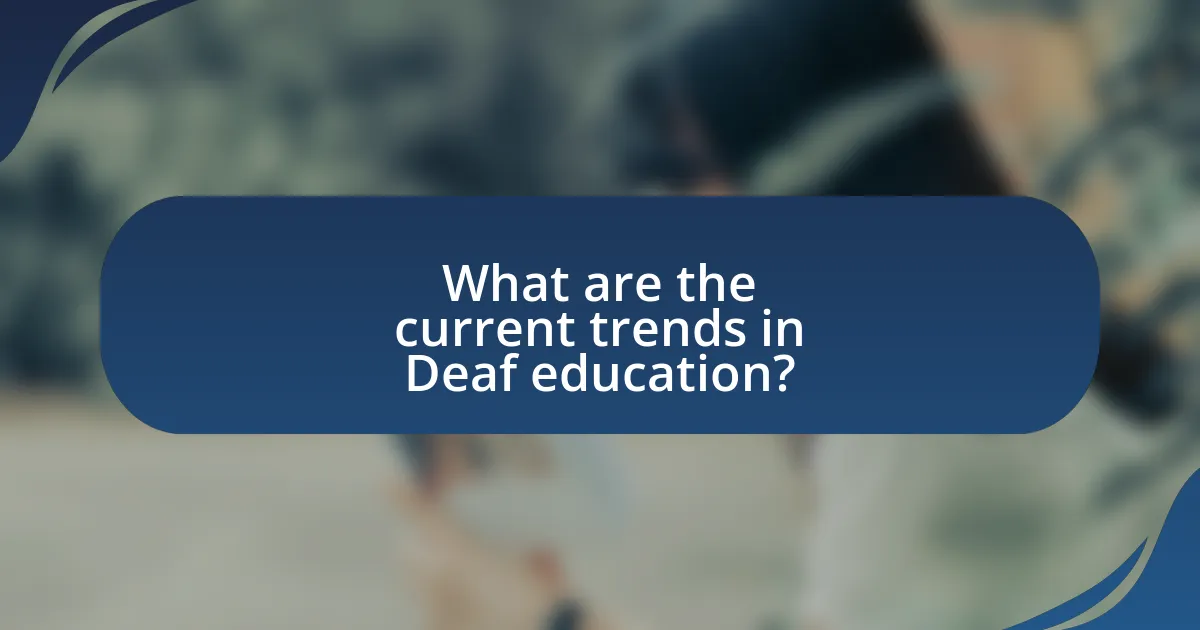
What are the current trends in Deaf education?
Current trends in Deaf education include the increased use of technology, such as video relay services and mobile applications, to enhance communication and learning. Additionally, there is a growing emphasis on bilingual education, promoting both sign language and written language proficiency. Research indicates that inclusive education practices are being adopted more widely, allowing Deaf students to learn alongside their hearing peers, which fosters social integration and collaboration. Furthermore, there is a focus on personalized learning approaches that cater to individual needs, supported by data-driven assessments to track progress effectively. These trends reflect a shift towards more accessible, equitable, and effective educational environments for Deaf students.
How are technological advancements shaping Deaf education?
Technological advancements are significantly shaping Deaf education by enhancing communication methods and accessibility. Innovations such as video relay services, real-time captioning, and mobile applications facilitate better interaction between Deaf students and educators, allowing for more inclusive learning environments. For instance, the use of video conferencing tools enables remote learning opportunities, which have become crucial during the COVID-19 pandemic, ensuring that Deaf students can continue their education without interruption. Additionally, research indicates that the integration of augmented reality (AR) and virtual reality (VR) in classrooms provides immersive experiences that cater to diverse learning styles, further supporting Deaf students’ educational needs.
What role do assistive technologies play in enhancing learning for Deaf students?
Assistive technologies play a crucial role in enhancing learning for Deaf students by providing tools that facilitate communication, access to information, and engagement in educational activities. These technologies include video relay services, captioning software, and specialized hearing devices, which enable Deaf students to participate more fully in classroom discussions and access instructional materials. Research indicates that the use of such technologies can significantly improve academic performance and social interaction among Deaf students, as evidenced by a study published in the Journal of Deaf Studies and Deaf Education, which found that students using assistive technologies showed higher levels of comprehension and engagement compared to those who did not.
How is virtual reality being utilized in Deaf education?
Virtual reality (VR) is being utilized in Deaf education to create immersive learning environments that enhance communication skills and social interactions. VR technology allows Deaf students to engage in simulated real-world scenarios, facilitating the practice of sign language and improving their understanding of social cues in a safe and controlled setting. Research indicates that VR can significantly increase engagement and retention of information among Deaf learners, as it provides visual and interactive experiences that cater to their learning preferences. For instance, a study by Kearney et al. (2020) demonstrated that Deaf students using VR for language learning showed a 30% improvement in vocabulary acquisition compared to traditional methods.
What pedagogical approaches are emerging in Deaf education?
Emerging pedagogical approaches in Deaf education include bilingual-bicultural education, technology-enhanced learning, and inclusive practices. Bilingual-bicultural education emphasizes the use of both sign language and spoken language, fostering cultural identity and communication skills. Research indicates that this approach improves language proficiency and academic achievement among Deaf students. Technology-enhanced learning incorporates digital tools and resources, facilitating interactive and personalized learning experiences. Studies show that the use of apps and online platforms can enhance engagement and accessibility. Inclusive practices focus on integrating Deaf students into mainstream classrooms while providing necessary support, promoting social interaction and collaboration. Evidence suggests that inclusive environments lead to better social outcomes and academic performance for Deaf learners.
How does bilingual education impact Deaf students’ learning outcomes?
Bilingual education positively impacts Deaf students’ learning outcomes by enhancing their language proficiency and cognitive skills. Research indicates that Deaf students who engage in bilingual education, which includes both sign language and written/spoken language, demonstrate improved literacy rates and academic performance compared to those in monolingual settings. A study by Lang et al. (2019) published in the Journal of Deaf Studies and Deaf Education found that Deaf students in bilingual programs scored higher on standardized tests and exhibited better comprehension skills. This approach fosters a deeper understanding of both languages, allowing Deaf students to access a broader range of educational resources and social interactions, ultimately leading to more successful educational experiences.
What is the significance of culturally relevant teaching in Deaf education?
Culturally relevant teaching in Deaf education is significant because it enhances engagement and learning outcomes for Deaf students by incorporating their cultural backgrounds and experiences into the curriculum. This approach acknowledges the unique linguistic and cultural identity of Deaf individuals, fostering a sense of belonging and validation in the educational environment. Research indicates that when educators integrate culturally relevant practices, such as using sign language and culturally pertinent materials, students demonstrate improved academic performance and social-emotional well-being. For instance, a study published in the “Journal of Deaf Studies and Deaf Education” by authors who examined culturally responsive pedagogy found that Deaf students showed increased motivation and participation when their cultural context was recognized and valued in the classroom.
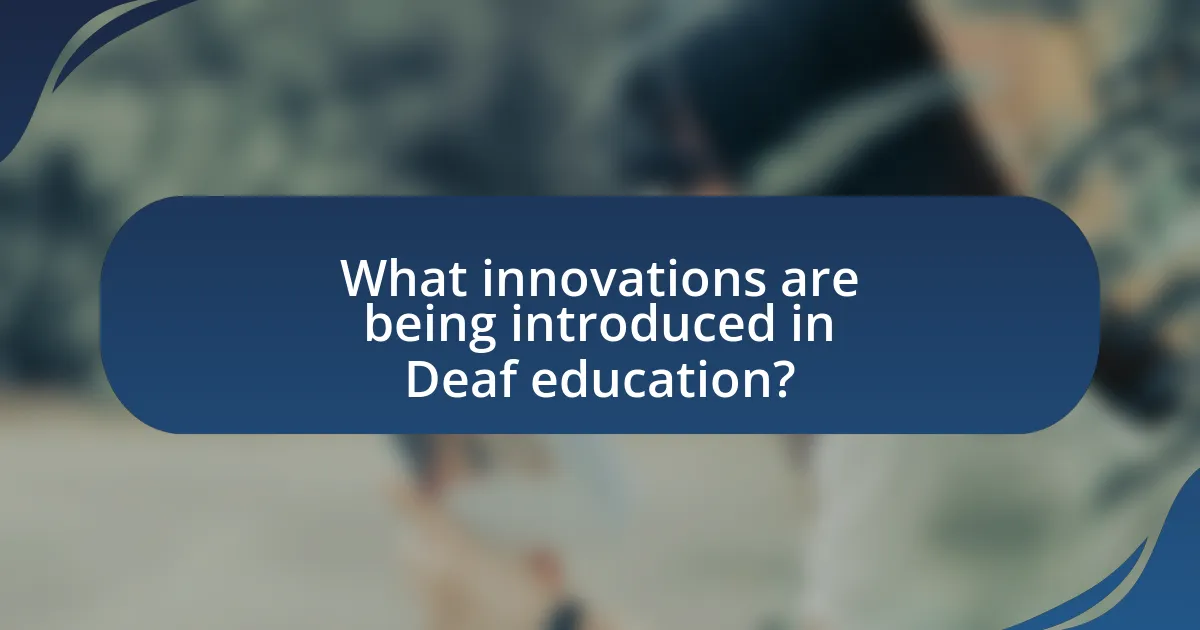
What innovations are being introduced in Deaf education?
Innovations in Deaf education include the integration of technology, such as virtual reality (VR) and augmented reality (AR), to enhance learning experiences. These technologies provide immersive environments that facilitate sign language acquisition and improve engagement. For instance, research from the University of California, Berkeley, demonstrates that VR can significantly enhance spatial awareness and social interaction skills among Deaf students. Additionally, the use of mobile applications for sign language learning and communication has increased accessibility and personalized learning opportunities. These advancements are reshaping educational methodologies, making learning more interactive and tailored to individual needs.
How are online learning platforms transforming Deaf education?
Online learning platforms are transforming Deaf education by providing accessible, flexible, and tailored learning experiences. These platforms utilize features such as video conferencing, captioning, and sign language interpretation, which cater specifically to the communication needs of Deaf students. For instance, research from the National Deaf Center on Postsecondary Outcomes indicates that online learning environments can enhance engagement and participation among Deaf learners, as they often allow for personalized pacing and the ability to revisit materials. Additionally, platforms like Gallaudet University’s online programs demonstrate how specialized content can be delivered effectively, fostering a more inclusive educational landscape for Deaf individuals.
What features make online platforms effective for Deaf learners?
Online platforms are effective for Deaf learners due to features such as visual communication tools, accessibility options, and interactive content. Visual communication tools, including video conferencing and sign language interpretation, facilitate real-time interaction, which is crucial for effective learning. Accessibility options, such as captions and transcripts, ensure that content is comprehensible and inclusive. Interactive content, like quizzes and discussion forums, engages Deaf learners actively, promoting better retention and understanding of the material. These features collectively enhance the learning experience by catering specifically to the communication preferences and needs of Deaf individuals.
How do online communities support Deaf education?
Online communities support Deaf education by providing accessible platforms for communication, resource sharing, and social interaction among Deaf individuals and educators. These communities facilitate the exchange of educational materials, such as sign language resources and teaching strategies, which enhance learning experiences. For instance, platforms like Facebook groups and specialized forums allow users to connect with experienced educators and peers, fostering a collaborative learning environment. Research indicates that online communities can improve educational outcomes by increasing engagement and providing a sense of belonging, which is crucial for Deaf students.
What role do mobile applications play in Deaf education?
Mobile applications play a crucial role in Deaf education by providing accessible communication tools, educational resources, and interactive learning experiences. These applications facilitate real-time communication through features like video calls and instant messaging, which are essential for Deaf students to engage with peers and educators. For instance, applications such as Glide and Sorenson’s ZVRS enable sign language communication, enhancing social interaction and learning opportunities. Additionally, educational apps like ASL App and SignSchool offer structured lessons in American Sign Language, allowing users to learn at their own pace. Research indicates that the use of mobile technology in education can improve engagement and retention, making these applications vital for effective Deaf education.
Which mobile apps are most beneficial for Deaf students?
The most beneficial mobile apps for Deaf students include Ava, Glide, and Sorenson BuzzCards. Ava provides real-time captioning for conversations, enhancing communication in group settings. Glide allows users to send video messages in sign language, facilitating direct communication among peers. Sorenson BuzzCards offers customizable flashcards for vocabulary and phrases, aiding in language learning. These apps have been recognized for their effectiveness in improving accessibility and communication for Deaf students, as evidenced by user testimonials and educational studies highlighting their impact on learning outcomes.
How can mobile technology facilitate communication for Deaf learners?
Mobile technology facilitates communication for Deaf learners by providing accessible tools such as video calls, messaging apps, and speech-to-text applications. These tools enable Deaf learners to communicate in real-time with peers and educators, breaking down barriers that traditional communication methods may impose. For instance, video calling allows for sign language communication, which is essential for many Deaf individuals. Additionally, messaging apps offer a written form of communication that can be easily understood, while speech-to-text applications convert spoken language into text, making it accessible for Deaf learners. Research indicates that the integration of mobile technology in educational settings significantly enhances engagement and learning outcomes for Deaf students, as it allows for personalized and immediate communication.
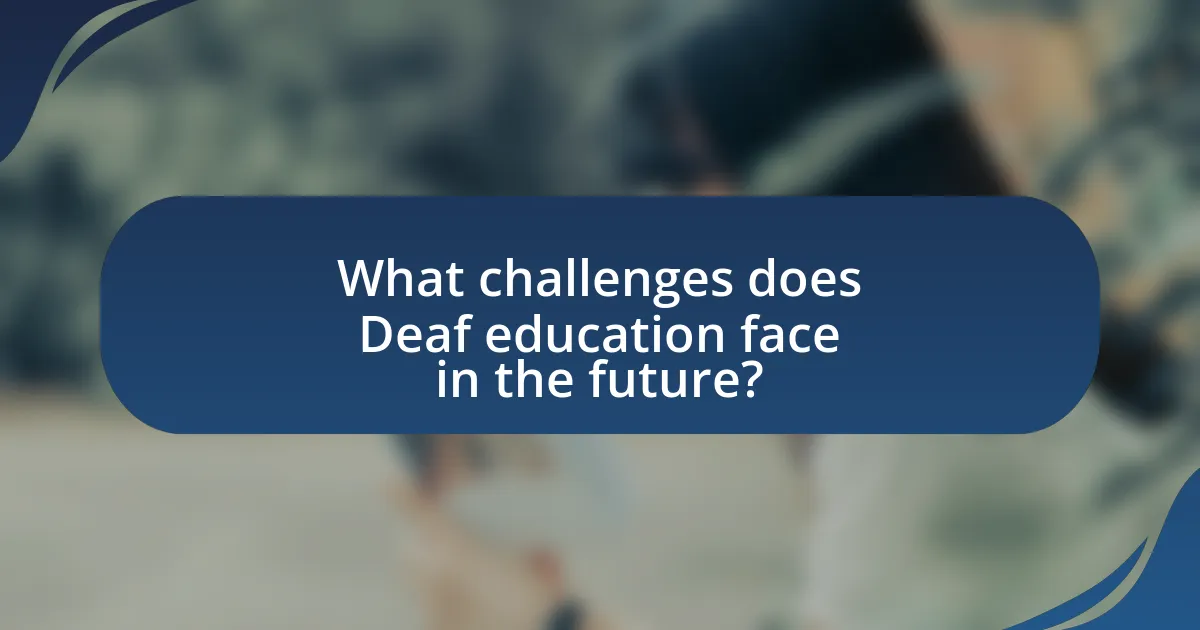
What challenges does Deaf education face in the future?
Deaf education faces significant challenges in the future, including accessibility to quality resources, integration of technology, and societal attitudes towards deafness. Accessibility remains a critical issue, as many educational institutions lack the necessary tools and trained personnel to effectively support deaf students. The integration of technology, while promising, also presents challenges in ensuring that all students have equal access to digital learning platforms and assistive devices. Additionally, societal attitudes can hinder progress; misconceptions about deafness may lead to inadequate support and inclusion in mainstream education. These challenges necessitate ongoing advocacy and innovation to improve educational outcomes for deaf students.
How can funding disparities affect Deaf education innovations?
Funding disparities significantly hinder innovations in Deaf education by limiting access to advanced resources and technologies. Schools with inadequate funding struggle to implement modern teaching methods, such as bilingual education or the use of assistive technologies, which are crucial for effective learning among Deaf students. For instance, a report by the National Deaf Center on Postsecondary Outcomes indicates that institutions with higher funding levels are more likely to adopt innovative practices that enhance educational outcomes for Deaf learners. Consequently, disparities in funding create unequal opportunities, stifling the potential for advancements that could benefit the Deaf community.
What are the implications of inadequate resources for Deaf education?
Inadequate resources for Deaf education lead to significant barriers in communication, learning, and social integration for Deaf students. These limitations can result in lower academic achievement, reduced access to qualified educators, and insufficient support services, which are critical for effective learning. Research indicates that Deaf students with access to appropriate resources, such as specialized teaching methods and technology, perform better academically and socially. For instance, a study by the National Deaf Center on Postsecondary Outcomes found that Deaf students who received adequate educational resources were more likely to pursue higher education and achieve better employment outcomes. Thus, the lack of resources directly impacts the educational and life opportunities available to Deaf individuals.
How can advocacy improve funding for Deaf education initiatives?
Advocacy can significantly improve funding for Deaf education initiatives by raising awareness and mobilizing support from policymakers and the public. Effective advocacy campaigns highlight the unique needs of Deaf students, demonstrating the importance of specialized educational resources and programs. For instance, organizations like the National Association of the Deaf have successfully lobbied for increased federal funding, resulting in programs such as the Individuals with Disabilities Education Act, which allocates billions annually for special education, including services for Deaf and hard-of-hearing students. By showcasing success stories and data on the positive outcomes of Deaf education, advocacy efforts can persuade stakeholders to allocate more financial resources, ultimately enhancing educational opportunities for Deaf individuals.
What barriers exist in implementing new technologies in Deaf education?
Barriers in implementing new technologies in Deaf education include limited access to resources, insufficient training for educators, and a lack of tailored content. Limited access to resources often arises from budget constraints in schools, which can hinder the acquisition of advanced technological tools. Insufficient training for educators can lead to ineffective use of technology, as many teachers may not be familiar with the specific needs of Deaf students or how to integrate technology effectively into their teaching methods. Additionally, a lack of tailored content means that existing educational technologies may not adequately address the unique learning requirements of Deaf students, resulting in less effective educational outcomes. These barriers collectively impede the successful integration of new technologies in Deaf education.
How can training for educators enhance the use of technology in Deaf classrooms?
Training for educators enhances the use of technology in Deaf classrooms by equipping teachers with the skills and knowledge necessary to effectively integrate digital tools into their teaching practices. Educators who receive specialized training can better understand the unique learning needs of Deaf students and how technology can support visual learning, communication, and engagement. For instance, research indicates that when teachers are trained in using assistive technologies, such as captioning software and visual communication apps, student participation and comprehension significantly improve. A study by the National Center on Deafness found that classrooms utilizing technology tailored for Deaf learners showed a 30% increase in student engagement compared to traditional methods. This evidence underscores the importance of targeted educator training in maximizing the benefits of technology in Deaf education.
What strategies can be employed to overcome resistance to change in Deaf education?
To overcome resistance to change in Deaf education, strategies such as stakeholder engagement, professional development, and the incorporation of technology can be employed. Engaging stakeholders, including parents, educators, and the Deaf community, fosters collaboration and addresses concerns, making them more receptive to changes. Professional development programs equip educators with the skills and knowledge necessary to implement new practices effectively, thereby reducing anxiety and resistance. Additionally, integrating technology, such as visual learning tools and communication apps, can enhance learning experiences and demonstrate the benefits of change, leading to greater acceptance. Research indicates that these strategies can significantly improve the implementation of innovative practices in educational settings, as seen in studies highlighting successful transitions in various educational contexts.
What best practices can enhance the future of Deaf education?
Incorporating bilingual education, utilizing technology, and fostering inclusive environments are best practices that can enhance the future of Deaf education. Bilingual education, which emphasizes both sign language and written language, has been shown to improve literacy and communication skills among Deaf students. Research indicates that students who are taught in a bilingual framework perform better academically and socially.
Utilizing technology, such as video conferencing and interactive learning tools, facilitates access to resources and enhances engagement in learning. Studies have demonstrated that technology integration in Deaf education leads to improved learning outcomes and greater participation in classroom activities.
Fostering inclusive environments that promote collaboration between Deaf and hearing students encourages social interaction and reduces stigma. Evidence suggests that inclusive classrooms benefit all students by promoting empathy and understanding, which is crucial for the holistic development of Deaf learners.
These practices collectively contribute to a more effective and equitable educational experience for Deaf students, preparing them for future success.
How can collaboration between educators and the Deaf community improve educational outcomes?
Collaboration between educators and the Deaf community can significantly improve educational outcomes by ensuring that teaching methods and materials are tailored to the unique needs of Deaf students. This partnership allows educators to gain insights into the cultural and linguistic preferences of Deaf individuals, leading to more effective communication strategies and instructional practices. Research indicates that when Deaf students are taught in environments that respect and incorporate their language, such as American Sign Language, their academic performance improves. For instance, a study published in the Journal of Deaf Studies and Deaf Education found that Deaf students who received instruction in their native sign language demonstrated higher literacy skills compared to those who did not. Therefore, collaboration fosters an inclusive educational environment that enhances learning and achievement for Deaf students.
What role does continuous professional development play in advancing Deaf education?
Continuous professional development is essential in advancing Deaf education as it equips educators with the latest strategies, tools, and knowledge to effectively teach Deaf students. This ongoing training enhances teachers’ understanding of Deaf culture, communication methods, and individualized instructional techniques, which are crucial for fostering an inclusive learning environment. Research indicates that educators who engage in continuous professional development are more likely to implement evidence-based practices that improve student outcomes, such as increased engagement and academic achievement. For instance, a study published in the “Journal of Deaf Studies and Deaf Education” highlights that teachers who participated in specialized training reported greater confidence and competence in addressing the unique needs of Deaf learners, ultimately leading to better educational experiences for these students.
